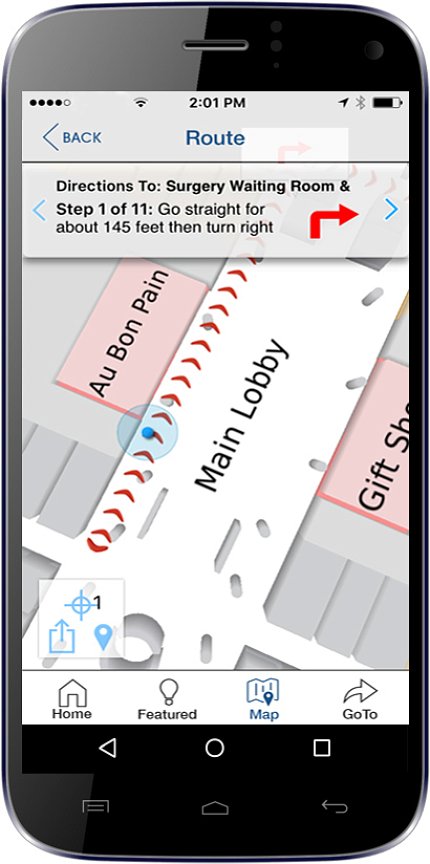Navigation App Makes Getting Around CC Easier

With 13,841 rooms and more than 13 miles of hallways, the Clinical Center invites getting lost. Now, however, a new and free navigational app will make getting around the hospital easier than ever.
The NIH CC Take Me There app allows users to follow turn-by-turn directions inside the hospital. It also features a directory that includes important information about the hospital. A web version is also available for those who don’t own a smartphone or tablet.
“This initiative can aid safety, operational efficiency and improve patients’ and visitors’ overall experience,” said CC director Dr. John Gallin. “The House of Hope, as we’re known, has a big heart, but it’s a big place, too. We’re pleased to respond to the wishes of patients, visitors and the NIH community to make the hospital easier to navigate.”
The app relies on Bluetooth low-energy beacons, said Eric Cole, chief of the Clinical Center’s Office of Administrative Management. The beacons emit a signal that’s picked up by a smartphone or tablet as long as Bluetooth is enabled on the device.
There are 855 beacons spaced roughly every 25-30 yards throughout common areas and hallways in the hospital, he said. The app’s accuracy is within 7-10 feet (2-3 meters).
The app combines indoor navigation with outdoor GPS navigation, Cole noted. For example, patients can open the app at home and enter their destination at the CC. If the patient is driving to campus, the app will direct him or her to parking reserved for patients. Once the car is parked, the app will save the location of the vehicle.
From there, the app seamlessly switches from outdoor to indoor navigation. If the patient misses a turn, the app automatically reroutes him or her. If a patient passes a laboratory that isn’t open to the public, a beacon activates an alert on the app that lets the user know he or she is near a staff-only lab. Once patients get to their destination, they will be able to provide feedback.
“We wanted to mimic the look and feel of a GPS system found in people’s cars,” Cole said. “The app also has turn-by-turn voice navigation that can be muted.”
The app does more than just get users to their destination, said Maria Maslennikov of the CC’s Office of Communications and Media Relations. She helped develop the app, which also features a staff directory that’s updated every 2 weeks and a real-time shuttle bus schedule.
The app also includes information about places of interest both on and off-campus. Patients and visitors can, for example, use the app to find the nearest mailbox, ATM, restroom in the CC or a restaurant in downtown Bethesda, she noted. Another feature gives users an opportunity to alert the CC’s housekeeping staff to areas of the hospital that need to be cleaned.
Maslennikov credited clinical research nurse Eva Sarbah-Yalley with suggesting the app’s name—“NIH CC Take Me There.”
Cole said development of the app began about a year ago, after the NIH advisory board for clinical research suggested that the CC determine whether new technologies could help patients and staff who had a difficult time getting around the hospital.
Already, he said, several hospitals interested in creating their own wayfinding apps have asked about the CC’s experiences.
“We’re very proud to have built a useful resource for patients, visitors and staff,” said Cole.
The NIH CC Take Me There app is available in English and Spanish and can be downloaded for free in Apple’s App Store and the Google Play Store.
